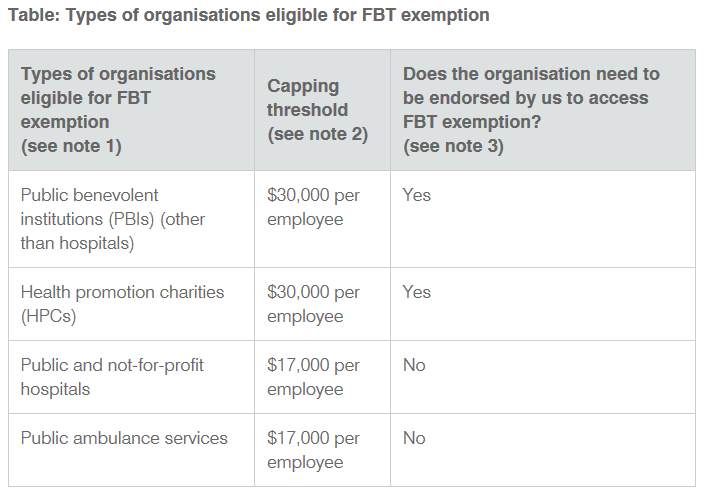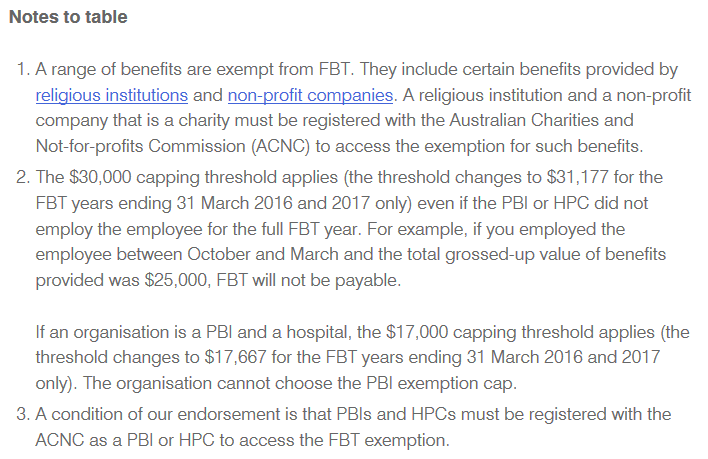According to the ATO website, fringe benefits tax (FBT) is a tax paid by employers on certain benefits provided to their employees, or to their employees’ family or other associates.
FBT is separate to income tax. It's calculated on the taxable value of the fringe benefit. As an employer, you must self-assess your FBT liability for the FBT year (1 April to 31 March).
If you have an FBT liability, you must lodge an FBT return and pay the FBT you owe.
For full and current information, please refer to the ATO website at https://www.ato.gov.au/business/fringe-benefits-tax/how-fringe-benefits-tax-works/.
What is a fringe benefit?
A fringe benefit is like a payment to an employee, but in a different form to salary or wages.
There are different types of fringe benefits. Examples include:
- allowing an employee to use a work car for private purposes,
- car parking,
- paying an employee's gym membership,
- providing entertainment by way of free tickets to concerts,
- reimbursing an expense incurred by an employee, such as school fees,
- giving an employee a discounted loan,
- giving benefits under a salary sacrifice arrangement with an employee.
For FBT purposes, an employee includes a:
- current, future or past employee,
- director of a company,
- beneficiary of a trust who works in the business.
If you're a sole trader or a partner in a partnership, you are not an employee. Benefits you provide to yourself are not subject to FBT.
Your clients are not employees. Benefits you provide to clients, such as entertainment, are not subject to FBT.
Who pays FBT?
The employer pays FBT.
This is the case even if the benefit is provided by a third party under an arrangement with the employer.
How much FBT do you pay?
To work out how much FBT to pay, you 'gross-up' the taxable value of the benefits you've provided.
This is equivalent to the gross income your employees would have to earn, at the highest marginal tax rate (including the Medicare levy), to buy the benefits themselves.
The FBT you pay is 47% of this 'grossed-up' value of the fringe benefits.
Which employers are be FBT exempt?
According to the ATO website, an FBT exemption is an exemption from paying FBT.
If your organisation is eligible for FBT exemption, benefits you provide to your employees are exempt from FBT if the total grossed-up value of certain benefits for each employee during the FBT year is equal to, or less than, the capping threshold.
If the total grossed-up value of fringe benefits provided to an employee is more than the capping threshold, your organisation will need to pay FBT on the excess.
The table below outlines the types of organisations that are eligible for FBT exemption, the capping thresholds that apply and whether the organisation needs to be endorsed by us to access FBT exemption.


Where is FBT Exemption status shown in Marlin HR?
It is displayed on the ATO Options tab in Options Maintenance (select System > Options from the Marlin HR menu).
By default, the exemption status is set to NO (i.e. unticked) as it is very unlikely that one of our customer businesses will be FBT Exempt.
The checkbox is 'read only' to prevent you inadvertently ticking it and reporting your exemption status incorrectly to the ATO.
Please contact Megabus if you are FBT exempt and need this checkbox ticked.

The FBT Exemption status is automatically included in the information reported to the ATO when you enter a fringe benefits amount for an employee.
Where to enter an FBT amount in Marlin HR?
The amount is entered in the Reportable FBT Amount field on the General tab in Employee Maintenance.
Please remember that the FBT year ends 31 March (not 30 June like the PAYGW Tax Year).

If the employer is FBT Exempt, an FBT Exempt Amount can also be entered (otherwise this field is read only).
The RFBA (Reportable Fringe Benefits Amount) to be entered is the grossed-up taxable amount of certain fringe benefits provided to a payee where the total of taxable and exempt benefits provided is in excess of $2,000 in the year (1 April to 31 March), and either the employer is not eligible for an exemption from FBT under section 57A of the Fringe Benefits Tax Assessment Act 1986 (FBTAA), or the employer is eligible for an exemption from FBT under section 57A of the FBTAA but the benefits were provided to an employee performing non-exempt duties.
The Reportable Fringe Benefits Amount and Fringe Benefits Tax Exempt Amount are included in the information reported to the ATO for the employee.